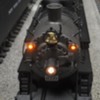First off some brief history and inspiration for this project. I have a couple of early PS2 MTH USRA Mikados. The first made in 2001 has PS2 5 Volt and wired tether and the second made in 2005 has PS2 3 volt and also a wired tether. MTH has made two subsequent NYC Mikes in 2007 with PS2 and wireless tether and finally in 2016 with PS3 and wireless tether. With each release MTH has made minor upgrades in detail and electronics.
The first 2001 issue came with pilot air hoses and rope pulls for the bell and whistle. The 2005 issue added cab curtains. The two with wireless tethers added engine decks, now that the wired tether was gone.
I have been gradually going through my early MTH steam (and other steam) and adding cab curtains and decks after straightening the tethers.
This is the 2005 engine showing the pilot air lines, lift bar with chain, and cab curtains (all from the factory) and engine deck which I added after straightening the tether. The drawbar was also replaced with a shorter one. (easy on a wired tether engine)
The K-Line engine came without pilot air lines, rope pulls, cab decks or curtains. To add the rope pull the bell was changed out to one with a lever. Yet to be replaced is a whistle with lever for the rope pull. Cab Curtains and deck were added and shorter drawbar installed. Coupling is now closer than the fitted drawbar would allow. Not a problem as this will get run on the club layout with 072 minimum curves.
This engine has been upgraded to K-Line Cruise. Still to be done a fan smoke unit. Three Lionel Mikes have yet to get this treatment including a Legacy USRA Light and Heavy. Their detail is the same as the stock K-Line. Parts to do this cost under 10 bucks with the bell being the expensive part.
Hopefully someone at Lionel will read this and add these details to their next production model.
Pete




















